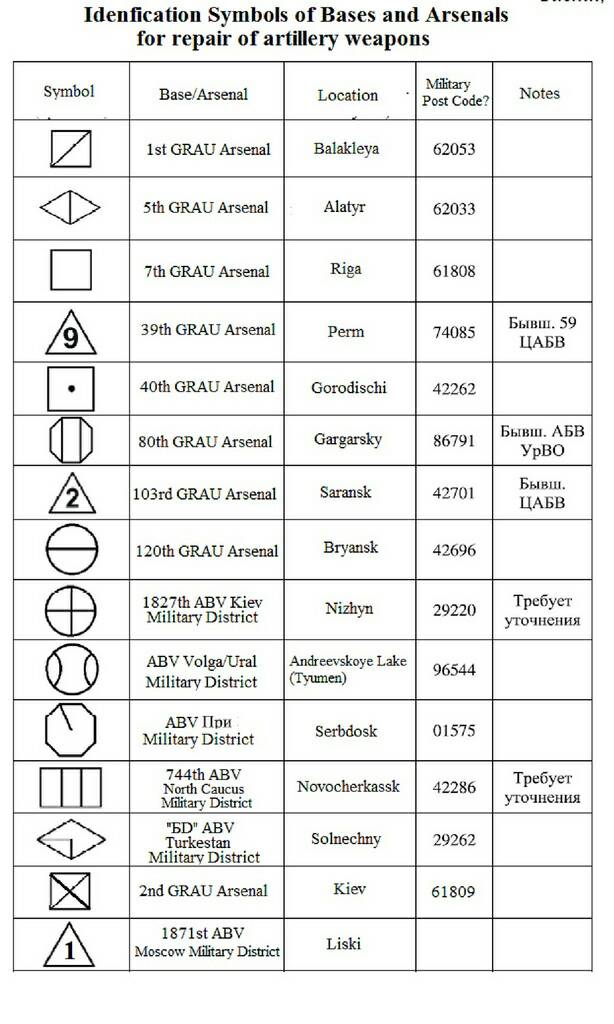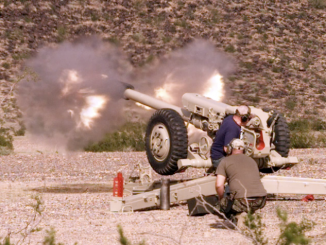One of the things that makes Mosin Nagant rifles particularly interesting to a lot of folks (myself included) is their tendentcy to appear in a vast number of conflicts all across the globe. Guns originally made in the US, France, and Russia wound up in all the Balkan nations, back in the US, Japan, Spain, Finland, and many other places. Tracing the paths some of these rifles have taken is a fascinating look back in time. Among these paths, one destination was East Germany – the DDR. For a long time, the general understanding among Mosin-Nagant collectors was that East German Mosins (as well as SKS rifles) were identified by a one-in-a-triangle marking:

Well, some research by a Russian collector named Ruslan Chumak has recently brought to light some new information about this marking and a bunch of others. In fact, it is a mark indicating that the rifle was refurbished by the 1871st ABV (Artillery Base for Ordnance) in the Moscow Military District – it has nothing to do with East Germany. It appears that the East German connection was first put in print by Lee Lapin in his Mosin-Nagant book, based on some similar marks that were used in the DDR on commercially produced guns. From there it became widely accepted, although some serious collectors remained skeptical, as rifles would occasionally surface with the /1\ marking which did not really make sense as being East German, like rifles with Balkan modifications. In addition the marking is never seen on any other known East German weapons, and it is seen on a lot of other Russian weapons (like the PPS-43).
Beyond just the /1\ marking, Mr. Chumak was able to positively identify several other arsenal refurb markings, which are commonly found on Mosins (you can download his full 480-page article in Russian here). Many of these markings have long been a mystery to collectors, and it is exciting to see them being slowly identified:




Perfect!! I’ll be stripping down my 1940 and 1943 Mosin’s tonight and checking for refurb marks. I’m hoping a reader out there can translate the Cryllic in the “Notes” column. Thanks Ian!
Tom, the Cyrillic in the notes column reads from top to bottom:
1) The former 59th Central Artillery Base for Rearming/Armament (or Munitions Arsenal, if you prefer a less precise translation)
2) Former Arsenal(? I’m not 100% sure on the acronym АБВ) of the Ural Military District
3) Former Central Artillery Base for Rearming/Armament (The assumption is that they didn’t change the number for this arsenal)
4 & 5) Requires further research/analysis.
Thank you Boris!
i like the fact that the russians are a productive bunch
and i like the fact that they make their work publicly available
but i need to learn the language
lol
so yhd markings listed in the picture are ones that East Germany received?
This is a fantastic resource, as it will help a lot of us to better understand the journey these old rifles have taken in their lives. I have a soft spot for Mosins as the first surplus rifle I ever acquired is a ’38 Tula Korean War bring back that I’ve had for over 35 years. It was the beginning of a costly addiction that plagues me to this day. Looks like I’ll be busy checking arsenal marks this evening.
The Mosin-Nagant rifle as each popular firearm has many stories binded with each example of it, but before the Mosin-Nagant rifle enter service many other design were tested, both Russian and foreign. The first Mosin rifle (called Mosin 1887) has tubular magazine in stock like Henry rifle. Mosin also design single-shot rifle, it was used to test that the bolt design is viable for smokeless powder cartridge. But later Mosin rifle with box magazine was rated as inferior to Nagant rifle (14 votes vs. 10 votes) and Mosin was requested to adapt features of Nagant rifle. After the field trials (300 examples of each rifle was used) the Mosin was the choice.
Source: В.Е. Маркевич Ручное огнестрельное оружие
That one-in-a-triangle stamp was an east-german quality label that could be found on many products:
http://de.wikipedia.org/wiki/G%C3%BCtezeichen_(DDR)
Yes, but note that in that usage the triangle has rounded corners. The marks in question on Mosin Nagant rifles are sharp-cornered.
that man is dedicated.
I for one would appreciate it if a person/persons would translate the Russian article into English.
Me too, but that would be a massive amount of work for someone to do.
Depends on which one article would you like to have translated – the 450 pages Ian refers to is a Vol.4(! – one wonders what was in previous three…) of the materials from a scientific historical conference held at St Petersburg Museum in 2014, and there are several individual articles, on fortification, uniforms, guns etc. First of all, the 25 MB dowloads forever – it’s now 15 minutes since I started to suck it in, and there’s still at least 25% left to go… When it downloads I’ll have a look and post the contents list. Perhaps one of our Russian posters could make a translation, or we can delineate some kind of a “gang-bang” job (many translators, each translating 4-5 pages) – but it would still take some time. When we’re finished, each translator would send his/her/its part to Ian for integration and posting. I’m not sure though about the copyright: publishing a translated material without some kind of an agreement with the author would infringe his copyright, wouldn’t it?
Actually, the article on Mosin-Nagant rifle and PPSh41 and PPS43 smg refurbishment facility marks is page 429 through 433. There is a larger graphic with even more marks, but not with locales for the marks. I can try to email it to any interested parties, if interested.
Cheers!
Talking about different Mosin-Nagants … here is a nice picture:
http://www.armoryblog.com/firearms/rifles/mosin-nagant-family-tree/
This is an excellent and very informative update for Mosin-Nagant enthusiasts. I agree wholeheartedly with Doc’s sentiments, as I have ended up in the same boat with regard to Mosin-Nagants — so many rifles with so many variations, and only finite resources with which to collect and enjoy them!
By the way, Ian, when you referred to “Lee Lapin”, did you actually mean Terence W. Lapin, author of “The Mosin-Nagant Rifle”, currently in it’s Sixth Edition and generally accepted as the definitive go-to source for Mosin-Nagants?
Yes, that’s the Mr. Lapin I am referencing (I used the name Lee from memory – not sure where that came from). Not to disparage his book, but it’s considered the go-to source because it’s pretty much the only source in English right now. Someone really ought to do a really detailed book on the Mosin, to the standard of the really scholarly works like Collector Grade Publications and others.
I recently bought a M38 with very strange markings, that I can’t find any reference to online. It has the normal Izhevsk arsenal marking, with a date on the barrel shank, above which is just a “1”. But on the left side of the barrel shank is “7,62 X 54R” followed by Eagle over N, “KD” and the German antler proof. Does any of the educated people here know what that means?